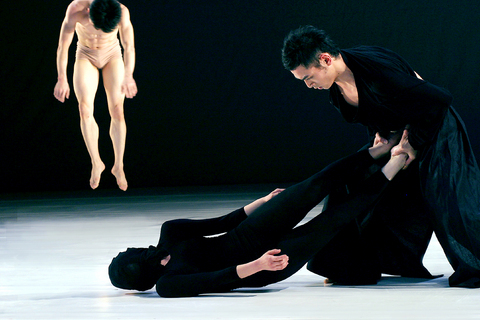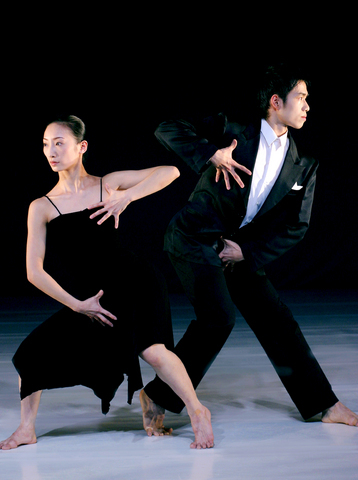It is with light feet but heavy hearts that Cloud Gate 2 dancers will take to the stage of Novel Hall this week for their Spring Gathering 2006. The company opened its 2006 tour last Saturday night in founder and artistic director Lo Man-fei's (羅曼菲) hometown of Ilan, just a few weeks after she died of cancer on March 24.
On the program is Lo's final work, Pursuing the Dream, Gloaming by Bulareyaung Pagarlava (布
Lo invited one of her favorite former students, Martha Graham Dance Company principal dancer Sheu Fang-yi (許

PHOTOS: LIN JING-YUAN, CLOUD GATE 2
The piece was a chance for Lo to collaborate with her elder sister Sophie Lo (羅蘇菲), a New York City-based singer. Sophie Lo will sing excerpts from traditional kun operas, including Peony Pavilion during the program, while Sheu dances the role of Tu Li-niang, who is willing to live or die for love.
"She [Lo Man-fei] made this piece because her sister can sing. She thought it would be a good chance to choreograph something for me and to work with her sister. Their relationship was very tight ... I know her sister is nervous that she will be too emotional to sing," Sheu told the Taipei Times in an interview before Cloud Gate Dance Theater's opening night for White X3 and Formosa two weekends ago.
Even though this is the second year in a row that Sheu is dancing with the company, she stressed that she is only a "guest."

PHOTOS: LIN JING-YUAN, CLOUD GATE 2
"I'm always waiting for the next invitation. It's not my main job. But this was a great opportunity to work with Bula [Bulareyaung] and with Lo Man-fei," she said.
Sheu acknowledged that Lo hoped that the company's dancers would be inspired by how she has carved out a full-time career as a professional dancer with an internationally renowned company.
"When Lo was young she really didn't take dancing seriously as a career until she saw the Alvin Ailey company and thought `maybe I can do that, maybe I should try that,'" Sheu said. "Maybe a young dancer here could have the same experience she did."
Sheu said she had gained a lot from Lo.
"Another gift Lo Man-fei gave to me was pushing me to try different places, letting me know that I have different talents -- as a rehearsal director, artistic director -- she didn't know if I could do it, but she trusted me [to try]," Sheu said.
Sheu will also be dancing in Gloaming, which she said was a change of pace from boyfriend Bula's piece for last spring's performance.
"It's about the period right before death ... almost the end, we call it jiang jin (將
The final piece, A Dignified Joke, is a little lighter, Sheu said, to have the audience leaving the theater on a happy note. Choreographer Cheng explores the human character and finds that behind each person's dignified appearance is a joke. In the piece, the 16 dancers put on layers of clothing and use new body language as they awkwardly try to move about.
After Thursday's opening night performance, the company has organized a special memorial for Lo. It will show a 1991 video of Lo performing her signature solo Requiem, choreographed by Cloud Gate Dance Theater founder and artistic director Lin Hwai-min (林
After the video is shown, Bulareyaung, Cheung and the company's dancers will place Lo's favorite flowers, yellow orchids, on stage in her honor. The company will also have extra flowers on hand for any audience members who would like to pay their respects to Lo.
Lo became the artistic director of Cloud Gate 2 in 1999 to foster young choreographers and provide a stage for young dancers, who range in age from 18 to 25.
"Lo Man-fei loved young talent, especially choreographers. We train a lot of good dancers [in Taiwan] but after they graduate what can they do?" Sheu said. "She wanted them to have a place to perform, to create a stage for them, a very, very good stage. Before [getting to] the big stage you have to start small and move up."
Cloud Gate 2 will go on without Lo, but who will step into her shoes as director is not yet known.
"One year after she [Lo] founded the company she discovered she had cancer. So for more than four years she was a patient and a company director. Like a European house director, she came to meetings and rehearsals, but left room for the dancers and choreographers to do their work." Lin told the Taipei Times in an interview earlier this month.
"I'm just babysitting it now. I don't know what is going to happen," Lin said. "I don't have other directors in mind at this moment."
However, he said, "I want [Cloud Gate 2] to do a lot of demos [demonstrations] on campuses ... do pieces without lighting or technical baggage, develop a repertoire of excerpts of all their pieces -- lots of duets, trios, quartets."
What: Cloud Gate 2 -- Spring Gathering 2006
When: Thursday, May 4 to Sunday, May 7 with performances at 7:45pm each night and matinees at 2:45pm on Saturday and Sunday.
Where: Novel Hall
Tickets: Prices range from NT$400 to NT$1,200; available through
www.artstickets.com.tw
The company will perform at National Sun Yat-sen University

In the March 9 edition of the Taipei Times a piece by Ninon Godefroy ran with the headine “The quiet, gentle rhythm of Taiwan.” It started with the line “Taiwan is a small, humble place. There is no Eiffel Tower, no pyramids — no singular attraction that draws the world’s attention.” I laughed out loud at that. This was out of no disrespect for the author or the piece, which made some interesting analogies and good points about how both Din Tai Fung’s and Taiwan Semiconductor Manufacturing Co’s (TSMC, 台積電) meticulous attention to detail and quality are not quite up to

April 21 to April 27 Hsieh Er’s (謝娥) political fortunes were rising fast after she got out of jail and joined the Chinese Nationalist Party (KMT) in December 1945. Not only did she hold key positions in various committees, she was elected the only woman on the Taipei City Council and headed to Nanjing in 1946 as the sole Taiwanese female representative to the National Constituent Assembly. With the support of first lady Soong May-ling (宋美齡), she started the Taipei Women’s Association and Taiwan Provincial Women’s Association, where she

Chinese Nationalist Party (KMT) Chairman Eric Chu (朱立倫) hatched a bold plan to charge forward and seize the initiative when he held a protest in front of the Taipei City Prosecutors’ Office. Though risky, because illegal, its success would help tackle at least six problems facing both himself and the KMT. What he did not see coming was Taipei Mayor Chiang Wan-an (將萬安) tripping him up out of the gate. In spite of Chu being the most consequential and successful KMT chairman since the early 2010s — arguably saving the party from financial ruin and restoring its electoral viability —

It is one of the more remarkable facts of Taiwan history that it was never occupied or claimed by any of the numerous kingdoms of southern China — Han or otherwise — that lay just across the water from it. None of their brilliant ministers ever discovered that Taiwan was a “core interest” of the state whose annexation was “inevitable.” As Paul Kua notes in an excellent monograph laying out how the Portuguese gave Taiwan the name “Formosa,” the first Europeans to express an interest in occupying Taiwan were the Spanish. Tonio Andrade in his seminal work, How Taiwan Became Chinese,